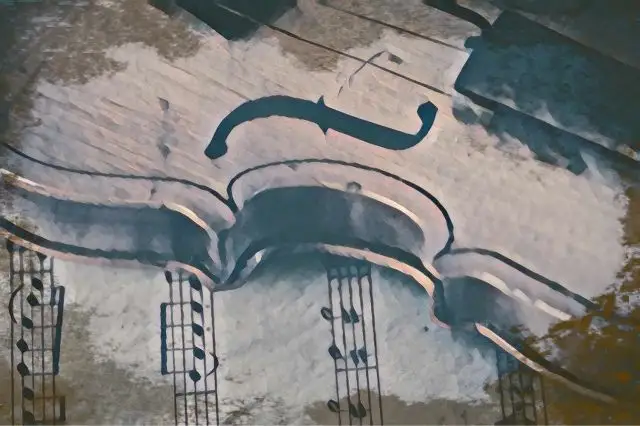Similar to the way that we articulate in our, we articulate in the way we play music. in the way we play music. In the same way that our spoken languages have rules, which determine the way that we speak and create phrases, our music does too.
However, these rules in music tell us how to play or sing particular notes or chords.
This is all referred to as articulation, and in this guide, we’ll focus on what articulation means and go over the various types of articulation that you can find in music to make your playing more expressive.
Articulation Defined
I often like to compare articulation in music to punctuation in language, as it gives us an idea of how to play a specific chord or note without impacting the actual quality of it.
Similarly, a comma in a sentence would tell you to take a pause, while a question mark in a sentence would tell you to put emphasis on the end. If you were to look at a melody on a piece of sheet music without any sort of articulation, all you would see are the notes that you must play, which are represented by the spaces and lines on the staff, as well as the duration of each note, which is given to us based on the tails and stems.
That sheet music also tells us the beats are in a measure and what keys were in, thanks to the key signature.
Articulation is the cherry on top, giving us more direction when it comes to expression.
You can take the same four-note melody and articulate it in different ways, playing it either short and stabby or long and flowy, with each note moving seamlessly into the next.
Some notes might be accented as softer or louder than the notes before, while others can have specific accents, telling the player or singer to emphasize them.
A piece of music can have as much or as little articulation as the composer pleases, and it's truly up to how specific they want to be with how the song is heard.
Let's take a look at a few different types of articulation that you can expect to find when looking at sheet music.
The Three Main Types of Musical Articulation
While there are many different kinds of articulation out there, most of them fall into three distinct categories, including:
- Length Change Markings - These are articulations that affect the length of a note, whether that means shortening or lengthening.
- Dynamic Change Markings - These articulations indicate volume changes of notes compared to the ones surrounding them.
- Relationship Change Markings - Some articulations are unique in that day affect the way groupings of notes are played. In the next section, we'll get into slurs, which are a good example of a relationship change marking, as they link two or more notes together.
Articulation In Musical Notes
As I said before, there are many different types of articulation that you can expect to find in music. Some of the most common articulation markings include:
- Staccato
- Slur
- Staccatissimo
- Tenuto
- Accent
- Marcato
- Fermata
- Portamento
- Sforzando
Let's take a deep dive into each of these articulation types and see what they do.
Staccato
Staccato is one of the most commonly used articulation markings in music. The word comes from the word “detached” in Italian, and in Musical terms, it means to play particular notes or grouping of notes separate from one another.
When you find a note with a staccato mark, which can be shown as a dot placed above or below the note head, you should play it short without attaching it to the next note.

If we look at the photo above, we can see that all the notes in the melody have a staccato marking underneath, meaning every single note should be played staccato.
One thing that you might also notice is that the staccato marking is placed either on the top or bottom of the note depending on which way the stem is facing. If the stem is facing up, you can find the staccato marking on the bottom. On the other hand, if the stem is facing down, you can find the staccato mark on top.
Slur
Another very common articulation marking in music is the slur, which some people refer to as a “phrase mark.” What's unique about this articulation mark is that it is the only one on this list that affects more than one note.
The slur is there to tell musicians or singers to play or sing a grouping of notes as a flowing phrase. Essentially, each note should feel connected to the next note, and so on.
If you're a saxophonist or a singer, for example, a slur would indicate that you should not take a breath between notes but instead play or sing all of them as a connected phrase. Someone who plays bowed string instruments would take the same cue, playing the notes groups with a slur in the same stroke of their bow.
You've likely heard the phrase “legato,” which is the style of articulation you get with a slur.
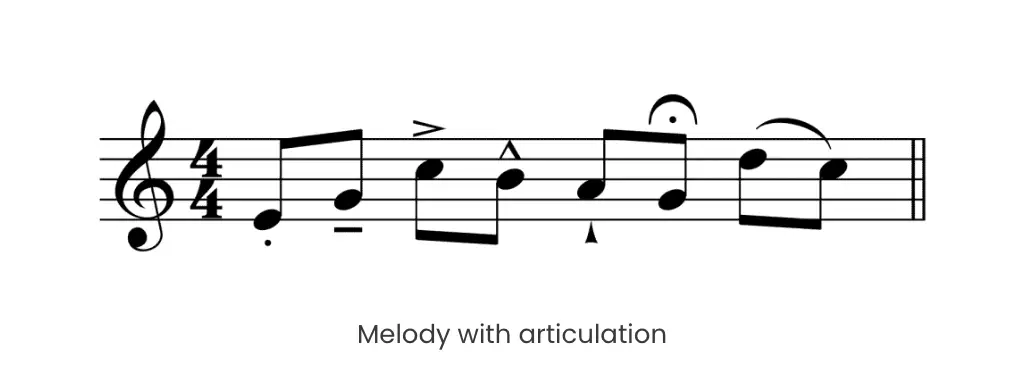
If you look at the last two notes of the melody, where the phrase moves from D to C, you can see the notes connected by a slur. Even though this particular Melody only shows two notes connected, it's worth noting that more than two notes can be connected with a slur.
The important thing here is that you don't get slurs mixed up with ties, which are used to tie notes together that share the same pitch. Slurs are always used between notes with different pitches.
Staccatissimo
Staccatissimo is very similar to staccato, though it uses the Italian suffix “-issimo,” which means “really” or “very.” So, as you might assume, this means to play the note very staccato or very short, keeping it as detached as possible from the other notes that come after.

If you look at the short melody below, you can see that all of the notes have staccatissimo markings, which are below the notes that have upward-facing stems and above the notes with downward-facing stems.
Tenuto
A Tenuto mark looks a lot like a tiny line placed either above or below a single note. As with most articulation markings, the placement of the Tenuto will depend on which way the stem of the note is facing.
Tenuto comes from the Italian phrase “to hold.” For musicians, it is a direction to hold or sustain an articulated note for the entirety of its value. It's important to remember that this is different from playing legato or with a slur, moving from one note to the next, as with a Tenuto marking, you are not necessarily merging two or more notes together.

It is also very different from staccato playing, as you're not shortening the note either.
Some players find Tenuto marking a little confusing, as it can mean slightly different things depending on the composer. In some cases, a Tenuto mark on a note can mean to play or sing the note slightly louder or longer than the other notes surrounding it, so that it sticks out. It might even mean holding out the note a bit longer than its standard value.
Accent
Accent marks do just as their name suggests, telling the singer or musician to accent a particular note with a stronger attack or louder approach compared to notes that do not have accents.
Beginners often make the mistake of thinking that accent notes affect note length, which is not the case. It's not like a legato marking, which essentially makes a note longer than written, or a staccato marking, which makes a note shorter than it is written.

In the melody above, you can see that all of the notes have been accented.
Marcato
The Marcato mark is a lot like an accented note, though with a bit more intensity. In the same way that you would play a note very staccato if you saw a staccatissimo marking, you would play a note very accented if you saw a Marcato marking.

The idea is to play or sing the note with more force or volume than the other notes surrounding it. It's easy to get the accent mark and the Marcaoto mark confused, though if you can remember that the Marcato mark is just an accent mark standing up, then you'll get it every time.
Another major difference between the accent mark and the Marcato mark is that the Marcato will always be placed above the note it is meant to articulate, even if you have a note with an upward-pointing stem.
Fermata
The fermata articulation mark probably has the most drastic effect on the way that a piece of music is articulated, as it changes the overall rhythm. Some musicians will refer to the fermata as a hold or pause, indicating that the specific note, rest, or chord, should be held out for longer than the standard value would tell you.

Depending on the composer, a fermata can be used to create a rhythmic difference that's barely noticeable. On the other hand, some composers or conductors will use a fermata to hold out notes as long as feels right in the moment. The beauty of the fermata is it creates a moment of tension or suspension, building anticipation for the end of a piece of music or before the beginning of the next bar.
When I was in music class in elementary school, my teacher used to refer to the fermata as the “bird’s eye,” as it looks just like one, using an open circle with a small dot in the center.
Portamento
Portamento is a unique articulation marking, as it is not found in all types of music. When you see a portamento marking on a piece of music, it suggests that you slide into the given note.
From what note you slide and for how long depends on the intention, as a large and long slide can sound much more unusual and suspenseful than a short one.
One of my favorite examples of portamento, and one that 90s kids will surely remember, is the small theme song (if you can even call it that) from the THX logo that used to appear before movies.
In fact, it's a pretty extreme example of portamento, as it features 30 different voices moving at various pitches throughout the frequency spectrum to a specific chord. Of course, you wouldn't find this same drawn-out style of portamento in your standard piece of music, though it gives you an idea of how far you can stretch it.
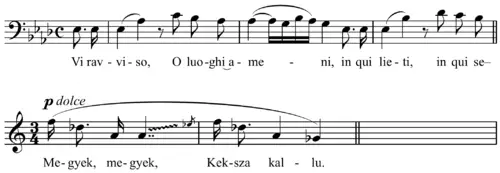
Portamento marks are very popular for instruments that can slide with ease, such as trombones.
Sforzando
Sforzando, a symbol that is very easy to recognize, thanks to the fact that it is just a combination of three letters found in the word, “Sfz,” is a unique accent mark and that it represents two distinct articulation marks in succession.
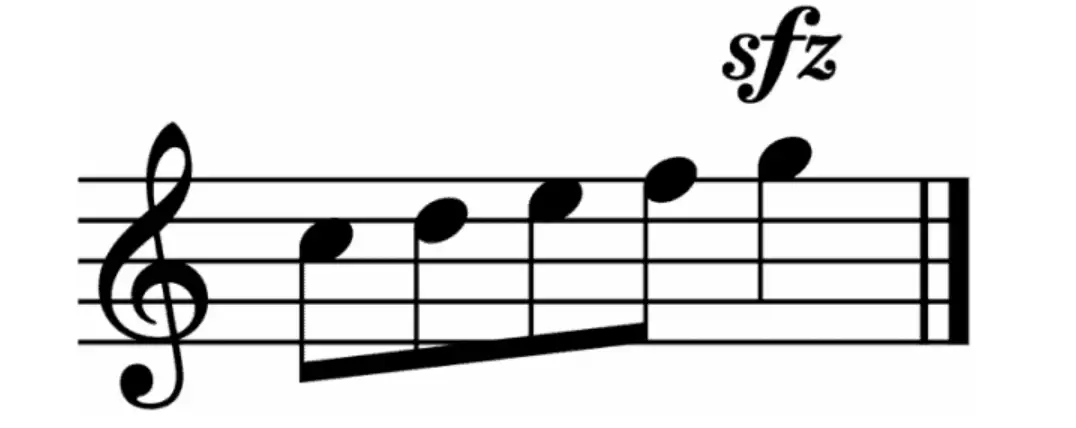
When you see a sforzando marking, it means to play the note very loudly at first and quickly reduce the volume so that it is soft. Think of it as an explosion, sending a shock to the system before pulling the listener and enforcing them to listen harder. There's nothing like sforzando to create a moment of interest.
Fortepiano
Though it is very similar to Sforzando, I figured I would quickly talk about another common articulation marking found in music, which is fortepiano.
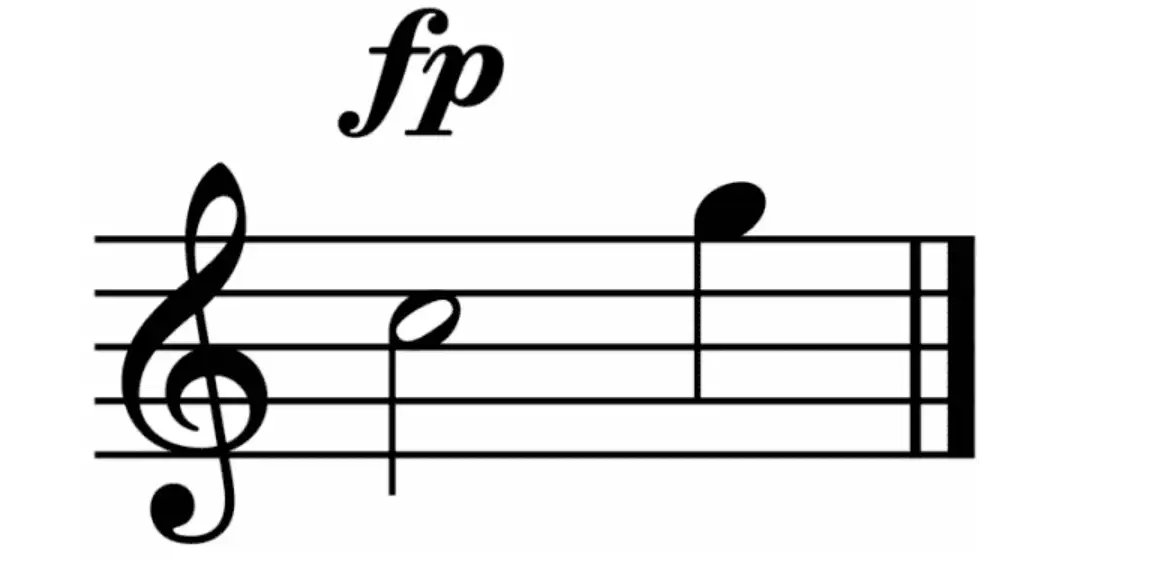
This marking is also easily recognizable, represented by an “fp.” Just like Sforzando, the fortepiano marking tells us to play a note very loudly before reducing the volume to an immediate quiet.
As a musician, it is a very difficult articulation marking to master and requires extreme dexterity and dynamic capability.
Getting Instrument- Specific
One of the neat things about articulation marks is that it can be very instrument dependent. Singers in a choir might find completely different articulation markings than brass players in a jazz band.
For example, if you play a brass instrument like a trumpet or a wind instrument like a clarinet, you might find a specific articulation mark that represents tonguing, which is when players use their tongues to tighten up airflow moving to their instrument to get a unique sound.
With wind instruments, you can use the tip of your tongue to play a note staccato or use the flat of your tongue to play a group of notes legato.
String instrument players will often see the pizzicato mark, which means to pluck with a finger rather than bow. Though it is labeled as pizzicato, the notes will sound as if they had staccato markings, even though it's a completely different mark.
This is because players can also play staccato, legato, or tenuto with their bows, and playing with a bow is called playing “arco.”
I could go on forever about how different instruments have different markings and dive deep into each one, though for the sake of this article, I'll keep it simple and leave you with an understanding that you should expect to find different markings depending on the instrument you play.
Final Thoughts - Articulations in Music
The easiest way to think about articulation marks in music is that it is simply the way we express ourselves in our playing. Articulation in music is a form of direction given by the composer, telling the player the intention of the conveyed message.
The beauty of music articulation is that it gives us several ways to customize and alter written music, whether it be the dynamic level, the duration, or the timbre. If you've ever played in an ensemble or saying a choir, you've no doubt heard the conductor or other musicians saying things like, “Play this phrase legato,” or “Sing that note staccato.”
Essentially, articulation symbols allow us to explore the technical finesse of every instrument, and as you continue playing and practicing reading sheet music, you'll master the art of articulation and become the most expressive player you can be.


